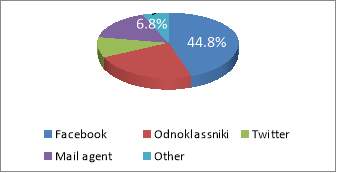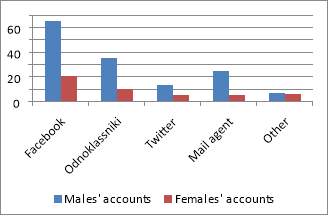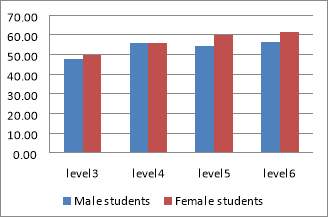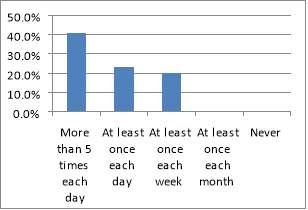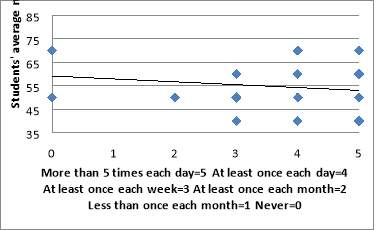Effect of Social Network Use on Academic Performance
Info: 8292 words (33 pages) Dissertation
Published: 26th Oct 2021
Tagged: Education
Abstract
The current research was aimed to determine the correlation between usage of “Social Network Sites” and students performance in Westminster International University in Tashkent (WIUT). Deductive approach was implemented in order to determine positive or negative correlation between the rate of SNS usage and academic performance of WIUT students; identifying the frequency of usage and level of necessity of SNS and find out if Social Network Sites are used as an educational tool among students of WIUT. The applied research strategy was based on self-administered questionnaires on first stage and semi-structural interviews on second stage.
The present study revealed that there is mainly negative correlation between hours spent in SNS and student’s performance (average mark). However, those students who visit their profiles once in a day 55%, report on average a higher mark comparing to their group mates. Moreover, the study revealed that students using SNS as a tool for their educational purposes also benefit from SNS.
Table of Contents
Introduction
Literature Review
Methodology
Approach
Strategy
Research instruments
Sampling
Viability
Reliability
Validity
Generalizability
Estimation results
Descriptive statistics of the SNS usage among WIUT students
Analysis of research findings
Conclusion
Recommendations
Expected results
Limitations
Further research
Bibliography
Appendices
Appendix 1: Social Networking Survey for Students
Appendix 2: The instructions for conducting questionnaire and interviewing
Appendix 3: Interview questions
Appendix 4: Data sample
Appendix 5: Description of the codes in the data
Appendix 6: Statistics
Introduction
Since the Social Network Sites (SNS) become more and more popular, the time dedicated to this activity is significantly increasing. Thus the following research was intended to check the correlation of SNS and students performance particularly in Westminster International University in Tashkent (WIUT). The following research question was proposed by the research team:
What are the impacts of social networking sites (SNS) on students’ performance in WIUT?
Furthermore, the study was orientated by the following research objectives:
- To identify the correlation between social networks and student’s performance.
- To measure the frequency of usage of the social websites among WIUT students.
- To examine whether the needs, perceptions, and learning of the students of WIUT are affected by social networks’ potential.
- To determine the impact of using social network sites as a tool for educational learning on students’ performance.
The report proceeds with critical literature review and implemented research methodology. Moreover, the results of the study and conclusions were presented. Finally the paper provides some recommendations to WIUT students and describes limitations that occurred while the research was conducted.
Literature Review
The increased use of social network sites has become a phenomenon for recent few years. The emergence of social network sites such as Facebook, Twitter, MySpace, Yahoo and many more caused a waste majority of young generations to accept the social networking as a usual way of life. Nevertheless, recent studies reveal that the increasing time spent on social network sites could decrease students’ academic performance and thus their grades. Students engaged in an active Facebook usage tend to check their profile updates on a regular basis at home or from some other places using their cellphones. Students also check their profiles while doing homework, which interferes with their preparation as they are distracted from their main occupation, and their working memory load is allocated to this task. All this facts should result in lower productivity and grades of the students (Rouis et al, 2011).
Moreover, many papers have examined comprehensively the role of social interactions in determining individual behavior and their impacts on the economic activity. Tham and Ahmed (2011) studied the adolescents aged 13-18 and found out that the profiles of those age groups contained a wealth of intimate, candid and a wide range of publicly available information on different social issues. Matching the outcomes of the study to Erik Erikson’s development stages, they tested identity exploration and role experimentation of those adolescents in the sample. According to the Erikson’s theory the adolescents aged between 13 and 18 experience a period of physiological crisis- identity versus role confusion (Tham and Ahmed, 2011). Tham and Ahmed (2011) believe that youngster undergoing that development stage becomes conscious about sexual identity, peer relations and other social interactions. Consequently, they argued that over-dependency on those media may adversely affect students’ attendance and thus performance.
According to the Flad (2010), although there many benefits of social networking such as keeping connected with peers and family members as well as sharing experience and socializing, the drawbacks of this phenomena sometimes outweigh. The new term revealed just recently “Facebook drama” demonstrates these drawbacks extensively. The students describe this drama as “friends posting upsetting messages, posting pictures that were not supposed to be seen by everyone, and students not being invited to join a “group” or party that everyone else seemed to be invited to” (Flad, 2010). All these negative factors can cause a long term stress and as a result decreased academic performance.
Moreover, in the research conducted by the Naizabekov (2012), it was also observed negative correlation of the usage of social networking on the student’ habits and completion of homework assignment. During the fall semester in University of Iowa, 83 first and 27 second-year students enrolled in various science courses (e.g. biology, chemistry, math and physics) were involved in a questionnaire. Almost two-thirds of students (64%) had admitted that spending substantial time on the SNS prevented them from the completing the assignment successfully. However, he argued that there was not a considerable difference between students who usually visited SNS and those who do not. In the study of Moon (2011), the survey of 400 undergraduate students has demonstrated that there is no any relationship between use of SNS and the academic performance of the students. Meanwhile the research found out that about 86.3% of freshman students actively interacted with Facebook during their assessment submissions which lead 25% of students to the conclusion of negative impact of SNS. Moreover, the hypothesis that the more students spend time on SNS the lower grades they obtain has been rejected.
Nevertheless, Taswir and Mehmood (2013) have found completely different outcomes from the empirical data while investigating pedagogical impacts of social networking sites on undergraduate students at the College of Applied Sciences (CAS), Nizwa, Oman. Despite some students perceived social networking sites to be a distraction and hesitated to share their feelings, the majority of respondents considered it as an avenue to search for information, be involved in educational networks and even look for career opportunities. Implementing the application of the social networks in classroom brought respondents a sense of belonging to an academic community, since the vast majority of their online friends were those they met in college. Importantly, the authors described the whole process of implementing social network application to classroom as being two step flow interactions-student to student and teacher to student.
Other sources indicate that even though extensive presence on Facebook tend to decrease student’s performance and overall productivity, the self-regulated students who control their presence on social networks and know how to use in an efficient way, can have some benefits other than social interaction. Hurt and Moss (2012) suggests that there benefits associated with social networks for educational purposes. Research has shown that Facebook usage enhances peer to peer interaction and stimulates informal education process. Schroeder and Greenbowe (2009) suggest that students using social network sites posted academically related discussion topics more frequently and more dynamically than did those who used the conventional course website. Furthermore, Hurt and Moss (2012) indicates that nearly 60% of students discuss educational related topics in social network sites, and thus social networks are not only used as social interaction tool, but also as an educational platform.
Divjak and Peharda (2011) conducted research to find the relationship between students’ academic performance and their position in social networks. Their primary outcome was that the students’ position in social websites cannot be determined by good or poor academic performance only, due to the fact that some successful students inclined to have good positions in social networking. Thus, the researchers tried to investigate the ways which can upgrade the student’s performance with the help of social web system and showed the usage of social net system to exchange learning materials, work within a team contributed to better students’ responsibility and participation in classes.
A more detailed research of the effect of the SNS on academic performance amongst genders was analyzed by Capó et al (2007), in which they scrutinized and discovered that female students were likely to expend more time on social websites compared to their male counterparts. Additionally, their research found out that as the students get older they spend less time on social networks. Focusing on the students’ academic performance mainly younger students suffered from the negative influence of social network. Generally, positive and negative correlations were detected between social network usage level and students’ age, field of study, gender and other factors. However, since the researchers used non-random sampling, their outcomes cannot be implicated in order to get the general view of larger population. On the other hand, Ishfaq and Qazi (2011) concluded found that male students tended to use those sites more. Moreover, the time spend on social sites had substantial influence on students’ study habits and academic achievement. However, the research did not observe any considerable effect of study area, level of education on social net usage rate.
To cap it all, even though extensive number of literature suggests that social network sites negatively impact the students’ performance, the number of literature that states that usage of SNS is neutral or even positively influence the educational process are also not in minority. The former group of literature is justifying its arguments simply stating that SNS encourage peer to peer, and student to mentor discussions, which in turn boosts students’ performance. Moreover, the reviewed literature did not examine the University of our Interest, particularly WIUT. Thus the positive and negative aspects of the SNS usage in WIUT was examined in the following study.
Methodology
Approach
In order to test the theories outlined in literature review section the deductive approach was implemented. This approach is concerned mainly on testing (not building) theories. It involves the development of a theory which is a subject to a rigorous investigation (Saunders et al, 2003). In other words the deductive approach is concerned with testing hypothesis. The particular research hypothesis was testing whether use of social network sites (SNS) has a negative impact on academic performance of the WIUT students. The study was aiming to clarify how SNS are effecting students, rather than why they are effecting. Hence, the researchers aimed to find the link between time spend in SNS and students’ performance in particular University, not the underlying reasons of this circumstance.
Strategy
To answer the proposed question, it was necessary to ask individual students whether they are feeling to be affected by the SNS in negative or positive way. Thus it was decided that the survey appears as the most suitable strategy. The research was intended to be cross-sectional, which means that it should be accomplished in a short period of time. The surveys are very popular strategy in business and management research, as they allow collection of a large amount of data from sizeable population in a highly economical way (Saunders et al, 2003). Moreover, the highly structured nature of the survey made the task of collecting and analyzing the primary data relatively easy.
The qualitative data collection was also accomplished i.e. interviews were conducted in order to eliminate the open ended questions and other related problems caused by questionnaire.
Research instruments
Initially list of questionnaire was distributed among the WIUT students. As the questions were constructed by taking into account the average number and level of students it did not cause any difficulties to do a proper survey. In order to obtain a precise view of the research students of the university were interviewed by the researchers, so it gave information about their attitude towards social networking sites. During conducting interview students’ honesty and readiness to answer all questions were appreciated. At first the research team decided to use solely questionnaires as the survey tool, however, as it appeared there is a limit to the number of questions that any questionnaire can contain if the goodwill of the respondent is not to be presumed on too much. (Saunders et al, 2003). Thus the semi-structured interviews were also conducted to make the survey as wide ranging as possible.
Sampling
Probability sampling was chosen, since it is commonly associated with survey-based research strategies, where inferences from a sample about a population served to meet objectives. Considering the confidence level it was targeted- that is, the characteristics of the data gathered will demonstrate the whole population and the margin of error (inaccuracy of the data) it could be tolerated, the actual sample size required was 181.[1] In calculation, actual required sample size interval of 15-35% was seen to be reasonable, as noted by Baruch (1999) (cited in Saunders et al, 2003), for most academic studies, above response rate was considered suitable. Having chosen the most appropriate sampling frame and established actual sample size required, it was chosen stratified random sampling technique to obtain a representative sample. The representative sample was stratified according to the educational level of respondents. Taking into the account the relatively large population size, required sample size for each educational level was set at 15% (e.g. Out of 500 students from Level-3, required sample size was 75 students, 52 out of 350, 37 out of 250, and 20 out of 130 students for Level 4, 5 and 6 respectively ).
Viability
The first aspect of viability is timescale. Since research was planned carefully using schedule, there was no difficulty in conducting every stage of research process in time. Another vital feature is resources such as data access, ethics and finance. The hindrances, which may arise from the physical access, were not faced, as both the participants and researchers were WIUT students. This position partly assisted the researchers in acquiring more authentic and valid information and reduced barriers to cognitive access, creating more ‘open’ atmosphere between researchers and respondents. Nevertheless, the existence of certain individual specific barriers to cognitive access, namely confidentiality of the academic performances and anonymity of the respondents were assured, to name a few, ensuring the sufficiency of the information needed to serve research objectives. In this case, in-depth explanation of the objectives, potential advantages of the study (e.g. particularly for the respondents themselves) and type of information required was helpful for building mutual-beneficial environment. Another not least important factor that was considered while obtaining cognitive access was ethical standards and practices. Hence, additional actions were taken to ensure rights and interests of respondents. In particular, being respondent of the study had to be in compliance with two criteria: randomly and voluntarily, meaning respondent could omit the questions that were considered to be confidential or simple refusing the participation altogether. Minor financial expenses were involved only for covering questionnaire postages, because research was carried in one organization, investigators analyzed the data themselves and therefore travelling and data synthesis costs did not occur.
Reliability
Whilst carrying out the investigation, researchers group gave priority to the threats which could weaken the reliability of the final result. Thus,
- Subject or participant error. The participants were explained the aim of the research and directions were given on how to fill out the questionnaire form. Moreover, the questionnaires were distributed for completion in convenient time of the students to avoid getting inaccurate data.
- Subject or participant bias. Good cognitive access and anonymity of the respondents enabled the team to attain unbiased replies from participants.
- Observer error. There might be some systematic errors committed by observers while collecting data.
- Observer bias. Observers might provide imprecise results to make alterations in the outcomes of the research. Unskillfulness of the observers in such kind of situations may stimulate observer bias.
Validity
Besides reliability, the validity may have got its own threats as well. The main culprit to invalidity of the findings might have come from inadequacy of the responses, since the research was mainly based on the primary data. The students, encountering a sense of shame or believing that the findings of the study may entail further both academic staffs’ and parental involvements, might have consciously ‘boosted’ their academic performance rates, while concealing the true information on SNS participation. By other words, students could have responded differently to the way they actually acted/thought. Conversely, students might have considered the study to be ineffective and less significant, believing that there is no correlation between academic performance of the student and SNS and thus unwillingly responding to the questionnaire. As aforementioned in viability part, to avoid these threats research team deliberately made a constant effort to create friendly environment by explaining the objectives and potential benefits the research findings may have as well as encouraging the respondents to be as open as possible.
Generalizability
While conducting the research it was concluded that the findings could not be generalized to other organizations, as this research analyzes only one local University. The research is specific to unique environment of the University, and accompanying factors will produce unique findings, non-applicable to other educational institutions.
Estimation results
Descriptive statistics of the SNS usage among WIUT students
| Graph 1. Social network site membership shares (%)
|
The most popular SNS amongst the students in the sample is Facebook. This phenomenon explained by the majority of the students was that the site renders a quick and easy way of communication coupled with the feature of anonymous profile visiting that makes the site more attractive. However, the others see the site as ways of easy integration options and free advertising opportunities. The Odnoklassniki and Twitter accounted for approximately 32% membership shares.
| Graph 2. Differences in the usage of SNS amongst genders
|
In accordance with the criterion of differences in the SNS usage amongst gender, males have appeared to have relatively more social network profiles that their counterparts. To support, males have Facebook, Odnoklassniki and Mailagent accounts three times more than females, whereas the dominance of men was observed by approximately 100% in using Twitter accounts.
| Graph 3. Average mark of students by gender and level
|
Despite having relatively higher proportion of shares in the usage of SNS, males have accomplished the given assignment with the same success as of females. Interestingly, as it is grouped the respondents in compliance with level, there was a phenomenon of constant downward degradation (from upper to lower levels) in the academic performance of females. For instance, level 6 female respondents have average marks of about 62% compared to the average marks of approximately 50 % of level 3 female students. However, average marks of male students from level 4 to 6 were within a narrow fluctuation of on average 55%.
Nevertheless, the frequency with which the students visit the SNS has adverse impact on their academic performance. As can be seen from the Graph 4, the majority of respondents independent from their levels visit the SNS at least once each day, constituting approximately 58%. In addition, about 30% of the respondents in each level use SNS more than 5 times a day. These revealed visiting preferences (e.g. frequently) of students negatively correlated with the submission of assignments on time. To support, those students who visit the SNS more than 5 times a day “suffered” 40% more from the challenge of late submission than those students who do not visit SNS at all.
| Graph 4. SNS usage by students at different levels (%)
|
Graph 5. Proportion of students who submitted assignments late because of SNS.
|
| Graph 6. The correlation between SNS usage frequency and students’ average mark
|
Likewise, negative correlation of SNS usage frequency was not only observed in the case of late submission but also with average marks of students. Those students who have never used the SNS have marks fluctuating around the mean of 60%, whereas the marks of those respondents who visit social sites, for example at least once a month or more than 5 times a day, incurred significant reduction on their performance (55 and 53% on average respectively).
Analysis of research findings
The analysis revealed generally negative correlation between time spent in SNS and students’ performance. In order to estimate the impact of social network sites on students’ performance in Eviews[2], several procedures were accomplished. Firstly, the “dummy variables were generated. Dummy variables assume values 0 and 1 only. For example, gender is actually dummy variable for female student. It is equal to 1 for a female student and 0 for male student. Its’ coefficient shows “how average mark changes when the value of gender goes from 0 to 1”, i.e. if it is positive then it indicates that female students take on average a higher mark comparing to male students and vice-versa.
Table 1. Outcomes of the regression analysis.
| Variable | Coefficient | Std. Error | t-Statistic | Prob. |
| C | 51.13324 | 3.664900 | 13.95215 | 0.0000 |
| FEMALE | 1.419599 | 1.863564 | 0.761766 | 0.4485 |
| LEVEL3 | -9.860599 | 1.836305 | -5.369803 | 0.0000 |
| FIRSTCLASSDIPL | 5.873984 | 1.761997 | 3.333709 | 0.0013 |
| MASTERSDEGR | 2.986369 | 2.054517 | 1.453562 | 0.1500 |
| FBMEMBER | 5.784063 | 3.603536 | 1.605107 | 0.1125 |
| ACCESSFROMCELL | -5.730491 | 2.336144 | -2.452970 | 0.0164 |
| CONTACTTHREMAIL | -1.605556 | 1.986960 | -0.808047 | 0.4215 |
| ATLEASTONCEEACHDAY | 0.610162 | 1.689498 | 0.361150 | 0.7190 |
| LATESUBMISSION | -3.894543 | 1.928376 | -2.019597 | 0.0468 |
| MORETHAN1INTERF | -1.921105 | 1.966172 | -0.977078 | 0.3315 |
| LEARNINGFROMSNSISIMPOR | 0.950685 | 3.038919 | 0.312837 | 0.7552 |
| SNSISIMPORTANT | 5.070332 | 2.308999 | 2.195901 | 0.0310 |
| R-squared | 0.435838 | Mean dependent var | 54.13043 | |
| Adjusted R-squared | 0.350143 | S.D. dependent var | 9.036212 | |
| S.E. of regression | 7.284427 | Akaike info criterion | 6.939623 | |
| Sum squared resid | 4191.968 | Schwarz criterion | 7.295962 | |
| Log likelihood | -306.2226 | F-statistic | 5.085896 | |
| Durbin-Watson stat | 1.979861 | Prob(F-statistic) | 0.000003 | |
The first variable that appeared in Eviews output was “female”. Its’ coeffcient is indeed positive and indicates that female students perfrom on average 1.4 % bettter comparing to their male groupmates. The other variables which indicate positive correlation with marks are the intendence of student to receive first class diploma and doing masters degree in future which are 5.87% and 2.98% respectively. As Facebook is the most popular social network site among others, it was decided to check whether it is negatively correlated with marks. The outcome however, was different than it was anticipated. According to the output the facebook membership is actually a positive factor (5.78%) in determining the students’ marks. Not surprisingly, those students who consider SNS profile as an important factor (5.07% percent of better performane), visit their profiles at least once in a day (0.6%) and consider using social network sites for their academic purposes, attain on average higher marks compared to others.
The variables with negative coefficients were the followings: Firstly, the Level-3 students were considered as majority of the students on this year of education usually attain the lowest marks(9.8% of lower performance). The reason behind this phenomeno lies in the fact that the traditional uzbek system of education is different than this implemented in WIUT. Thus students maybe either shocked and stressed from unusual educational approach, or take the mostly student self-regulated british education style unimportant and thus receive lower marks. The next factor that influence the students’ performance in a negative way is the students’ incentive to check their profiles using their cellphones. The students increase their interference with SNS, as checking their profiles becomes a more easy task, which in tern increse the negative impacts of SNS usage. The variables namely “latesubmission” (-3.8%) and “morethanoneinterfere”(-1.92%) also indicate a negative coefficent. The first variable illustrates the students who have at least one coursework submitted after the deadline (late submission) because of the SNS, wheras the second one indicates the students who interfere with SNS more than once in a day, which also appeared to be a negative factor in determining once mark. The estimated regression analysis do explain the some of the variations in the academic performance of students. As can be seen from the table 1, the value of the R-squared (e.g. goodness of fit) was equal to 44%, which indicates that independent variables considered in the model cover only about a half changes in the dependent variable (academic performance of students measured in terms of marks).
Conclusions
Objective 1: To identify the correlation between social networks and student’s performance
The research analysis showed that there is indeed a negative correlaton between hours spent in SNS and students performance in WIUT. The findings indicate that average mark of the student declines as hours spent and frequency of SNS usage increse. Those students who visit their SNS profiles more than once in a day and spent on average more than two hours, tend to receive lower marks compared to those with less frequent usage of Social network sites, what supports the findings of Rouis (2011) who also indicate the negative relationship between usage of SNS and students’ grades. However, the study also revealed that those students who visit their profiles once in a day, and consider it as an important tool for their academic purposes, tend to receive higher mark comparing to those who visit SNS profiles more frequently or do not use them at all, which in turn support the findings by Hurt and Moss (2012).
Objective 2: To measure the frequency of usage of the social websites among WIUT students
The findings indicate that majority of the WIUT students on each level tend to check the SNS profiles at least once in a day. Level 3 and 4 students who visit their profiles at least once a day accounted for 55%. Level 6 students were among the most frequent users of SNS, more than 60% of whom indicated that they use SNS at least once a day. The Level 5 students who visit their profiles daily were among minority, as they accounted for roughly 50% of overall number of level 5 respondents. About 30% of the students reported that they visit their profiles more than 5 times each day, which can be attributed to the main factor causing the negative correlation of SNS and students performance. The students who visit their profiles at least once a week accounted to 12 % of overall sample, and students who do not have their profiles were among minority with less than 4% of the surveyed sample.
Objective 3: To examine whether the needs, perceptions, and learning of the students of WIUT are affected by social networks’ potential
The analysis revealed that students generally consider SNS as an important aspect of their life, more than 50% visit their profiles once a day, while students who visit more than 5 times is 30% of the sample. This indicates the necessity of not only being a SNS member, but also the necessity of interacting within this particular social framework. Moreover, the majority of students also consider the SNS as an important tool for learning, which indicates the potential lying behind the social network sites.
Objective 4: To determine the impact of using social network sites as a tool for educational learning on students’ performance
The researchers did find the positive impact of using SNS as a tool for educational purposes, only in case when students are aware that they can academically benefit from Social Networks and do not use them too frequently. Those students, who visit their profiles no more than once in a day and trying to benefit from these sites academically, are on average performing 5% better comparing to other surveyed students with different perceptions, confirming the research conducted by Taswir and Mehmood (2013), who investigated the pedagogical impacts of social networking sites on undergraduate students.
Recommendations
The empirical analyses of the data showed that there is generally negative correlation between time spend in SNS and students’ performance. However, the research also revealed that students who use their SNS profiles as learning tool benefit in educational aspect. So, taking into account all this facts the research team proposed the following recommendations to WIUT students:
- It is advised that those students who use SNS profiles more frequently (more than 5 times a day) start to visit them once only.
- Students are advised to start using and consider social network sites as educational tool that helps them to engage in peer to peer education and as an avenue to search for information, be involved in educational networks and even look for career opportunities (Taswir and Mehmood, 2013).
- Students are recommended to not enter their profiles from their cellphones. As this function makes it considerably easier task to enter SNS and as a result the frequency of profile visiting increases, which is negatively correlated with their academic performance.
- It is also advised to open SNS profiles and engage into more enhanced peer to peer education and information sharing to those students who do not use social network sites.
Expected results
According to our findings if students register in SNS and visit them only once in a day and solely for educational purpose their average academic performance should increase.
Limitations
Time constraint. Sincethe questionnaire was filled out within a short period of time, there might be the possibilities of responses being superficial and insufficient in content that might entail hindrances in interpreting estimation results.
Response rate. At the beginning stage of the research, it was initially planned to obtain a sample of 200 respondents from approximately 1500 students in WIUT. Unfortunately, only 184 papers were returned back and out of those 3 respondents were considered to be potentially ineligible (i.e. the issues of confidentiality). Hence, the overall comprehensiveness of the gathered quantitative data was limited.
Response bias. This type of bias may essentially be caused by the perceptions about the questions (e.g. perceived questionnaire bias). Nevertheless, this does not necessarily mean that the cause of this type of bias is directly linked to the questionnaire itself. Being a respondent of a questionnaire is an intrusive process. This was especially true in the case of constructed questions, where it was simply aimed at exploring the relations of SNS usage and academic performance. However, certain questions in the research were subject to exploration of “sensitive themes” (e.g. disclosure of exact marks). Consequently, along with response rate challenges, perceived questionnaire bias might also reduce sufficiency of the coverage of the research objectives.
Sampling. The limitation on the sampling had been faced due to the time constraint mentioned above. Initially, it was planned to set a sample rate at 25% out of 1500 students (as it was discussed in sampling part, the most appropriate sampling range should be set at 15-35%). Since, the research schedule was organized with the dedication of no more than 2 days on the distribution and gathering of all questionnaire responses, the sample rate of 25% was considered to be unfeasible as a result of the type of sampling (e.g. stratified sampling where it was supposed to obtain responses of students from each level). Thus, employing the least rate from the requirement might entail subjectivity in judgments and reduce the comprehensiveness as well.
Variability boundaries in questions. The extension of the diversity of questions was impossible as the simplified nature of questionnaire was chosen. This potential boundary in the research led to reduction in the ability of obtaining as much information as needed.
Data quality. Despite having provided sufficient instructions and recommendations that might assist the respondents in reading and answering the questions, the research team could have rendered a more mutual-beneficial question-answer environment for students. That inability in creating more proper condition for the students might have reduced the quality of the obtained data.
Further research
The estimated outcomes of the research might be subject to the confidentiality and personality factors. Firstly, although the research team has made a constant effort to convince the respondents on the issues of ethics and confidentiality, there were still some biases in the data collection period. Most importantly, the confidentiality issues have burdened the team when the respondents replied to the questions concerning their marks (i.e. may be due to the shame of low mark). Hence, further research may implement such type of questionnaire that would render proper anonymity of the respondents or ask simply academic regulation members (e.g. register office) to provide the detailed data-set on the marks of students from which it can be taken sample. Secondly, the respondents’ perceptions of positive and negative aspects of the SNSs could have been influenced by personal preferences. Thus, it may be helpful if the further research construct a questionnaire that include more personality related questions, which may be then used to reveal “perfect” preference (e.g. preference differences) towards the SNSs, for example.
Bibliography
Ahmed, I. Amir, M. Qazi, T.F. and Jabeen, Sh. (2011) An Investigation of SNS Usage and Its Impact on Studying Habits and Academic Performance of University Students. Research Journal of Internatıonal Studıes, (21). 145.
Capó, M., Coromina L., Ferligoj A., Matelič U. and Coenders G. (2007) Networks of PhD Students and Academic Performance: A Comparison across Countries. Metodološki zvezki, 4 (2), p.205-217.
Divjak, B. and Peharda, P. (2011) Relation between student academic performance and their position in a social network. Varazdin. University of Zagreb.
Flad, K. (2010) The Influence of Social Networking Participation on Student Academic Performance Across Gender Lines. [online]. Available from:
Hurt, N. and Moss, G. (2012) The ‘Facebook’ Effect: College Students’ Perceptions of Online Discussions in the Age of Social Networking. [online]. Available from:
Ishfaq A. and Qazi T.(2011). A look out for academic costs of SNSs, a student based perspective. African Journal of Business Management, 5(12), 5022-5031
Karlin, S. (2007). Examining how youths interact online. School Board News, 73 (4):6-9.
Moon, A. (2011) The Impact of Facebook on Undergraduate Academic Performance: Implications for Educational Leaders. Doctor of Education. Central Michigan University.
Naizabekov S. (2012). Negative impact of social networking sites on academic performance of students. [online]. Available from:
Rouis, S., Limayem M., and Salehi-Sangari E., (2013) Impact of Facebook usage on Students’ Academic Achievement: Roles of Self-Regulation and Trust. Electronic Journal of Research in Educational Psychology, 9 (3), p.961-994.
Saunders M., Lewis P. and Thornhill A. (2003) Research Methods for Business Students. 3rd edition. Harlow: Pearson Education Limited
Schroeder, J, and Greenbowe, T. (2009). The chemistry of Facebook: Using social networking to create an online scientific community for the organic chemistry laboratory. [online]. Available from:
__Using_Social_Networking_to_Create_an_Online_Community_for_the_Organic_Chemistry_Laboratory.pdf> [Accessed: 1 March 2013]
Srivastava, P. (2012) Social Networking & Its Impact on Education-System in Contemporary Era. International Journal of Information Technology Infrastructure, 1 (2), p.11-18.
Tham, J. and Ahmed, N. (2011) The usage and implications of social networking Sites: A survey of college students. Journal of Interpersonal, Intercultural and Mass Communication, 2 (1).
Appendices
Appendix 1: Social Networking Survey for Students
1. Please indicate your gender
Male ____________ Female_____________
How old are you?
______
2. Please indicate your level
CIFS_______ Level4_______ Level5________ Level6________
3. What is your current mark average?
70+ _____ 60-70 _____ 50-60 _____ 40-50 _____ 30-40 _____ Lower than 30_____
4. What type of diploma do you plan to receive at graduation?
First class _____ Second class _____ Diploma of any type_____
5. After graduation, do you plan to study Master’s degree?
Yes _____ No _____ I don’t know ______
6. Which social networking websites are you currently a member of?
Facebook ____ Odnoklassniki____ Twitter ______ Mailagent ______
Other: ________________________________ None_______
7. Have you ever accessed a social networking website on your cell phone?
Yes _____ No _____
8. Do you have any settings activated so that information from a social networking website
can contact you through your email address?
Yes _____ No _____
9. How often do you typically visit a social networking website? (Please select one)
More than 5 times each day __________
At least once each day _______________
At least once each week ______________
At least once each month _____________
Less than once each month____________
Never ________
10. Have you ever been late handing in an assignment because you spent time on a social networking site instead of writing cw?
Yes _____ No _____
11. How often has spending time on a social networking website interfered with your ability to study or complete assignments?
Several times _____ More than one time _____ One time _____ Never _____
12. True or False: What I learn on a social networking website is more important than most of the things I learn at university.
True _____ False _____
13. How important to you is your membership(s) on social networking website(s)?
Very Important _____ Important _____ Somewhat Important _____ Not Important _____
Appendix 2: The instructions for conducting questionnaire and interviewing
- Researcher(s) should be ensured voluntary informed consent of participation.
- Researcher(s) should be honest and straightforward in his/her relations with respondents
- Researcher(s) should be transparent concerning the subject and data collection purposes
- Researcher(s) should ensure the issues of ethics and respect the confidentiality of the collected information
- Researcher(s) should make a constant effort not to harm and adversely affect the respondents
- Researcher(s) should ensure that the chosen respondents have willingness to contribute to the research that may be observed in their appropriate training, experience or educational background.
Appendix 3: Interview questions
1. Do you think your time spend in SNS effects your academic performance in positive or negative way? Why?
2. How convenient do you find it to enter your SNS profile from cellphone for academic purposes?
3. Do you ever find it useful to use SNS as one of the sources to accomplish your academic task?
4. How often do you tend to check your SNS profile while preparing your academic assignment? (for example: studying, writing a paper, reading, researching information, working on a project, during group work)
5. Do you find it more convenient to discuss academic related issues in your SNS profile rather in face to face conversation? Why?
Appendix 4: Data sample
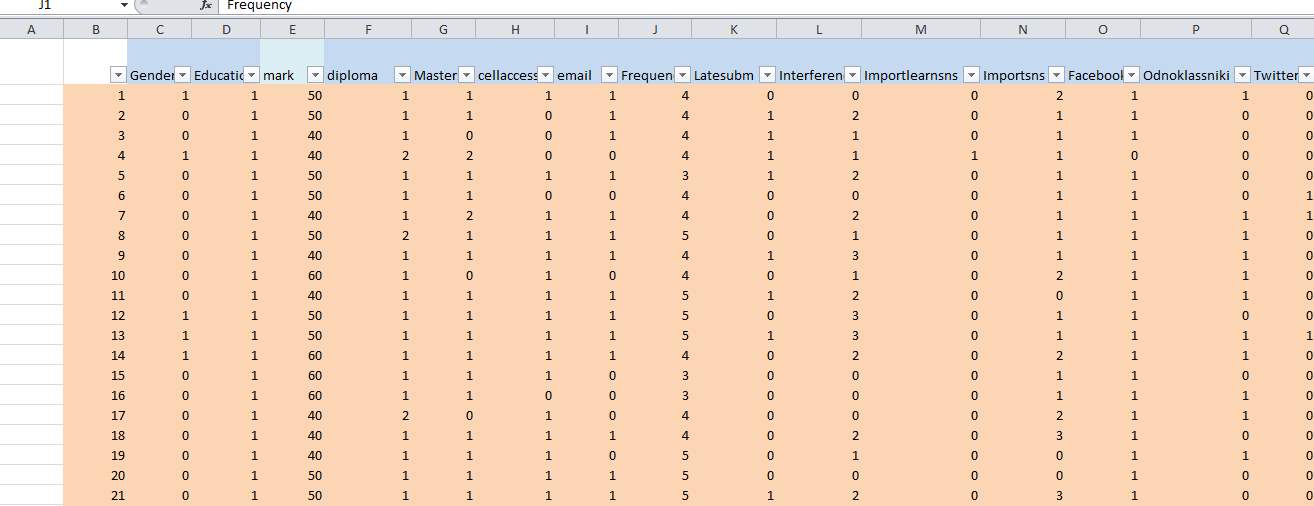
Appendix 5: Description of the codes in the data
| 1 | Gender | gender 0f respondent 0 for male 1=female |
| 2 | Education | cifs=1 level4=2 level5=3 level6=4 |
| 3 | current mark | |
| 4 | Expected diploma | first class=1 second class=2 lower=3 |
| 5 | Masters degree | yes=1 no=0 I don’t know =2 |
| 6 | membership | |
| 7 | access from cell | yes=1 no=0 |
| 8 | contact to email | yes=1 no=0 |
| 9 | frequency | more than 5 times each day=5 at least once each day=4 at least once each week=3 at least once each month=2 less than once each month=1 never=0 |
| 10 | late submission | yes=1 no=0 |
| 11 | interference | several times=3 more than one time=2 one time=1 never=0 |
| 12 | importance of learning from sns | yes=1 no=0 |
| 13 | importance of sns | very important=3 important=2 somewhat=1 not important=0 |
Appendix 6: Statistics


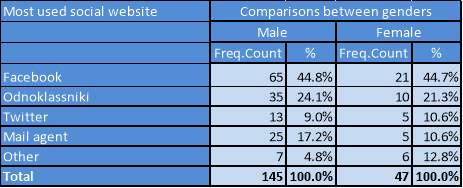

[1] Considering an approximate number of WIUT students of 1500, it is decided to take 15% sample of the whole population. Unfortunately, it was only possible to obtain 184 respondents answers out of the 200 sample. Out of those potentially reachable respondents, 3 of those were ineligible, since the questionnaire was organized in a voluntary manner (as discussed in viability part), those three respondents refused to answer for the majority of the questions (e.g. confidentiality issues), thus considered to be ineligible to respond.
[2] Eviews-Econometric Views
Cite This Work
To export a reference to this article please select a referencing stye below:
Related Services
View allRelated Content
All TagsContent relating to: "Education"
Education is the process of teaching or learning, especially systematically during childhood and adolescence, in a school or college, or the knowledge that someone gains from this. Post study, education can mean the imparting or acquiring of specific knowledge or skills required for a task, or profession for example.
Related Articles
DMCA / Removal Request
If you are the original writer of this dissertation and no longer wish to have your work published on the UKDiss.com website then please:

